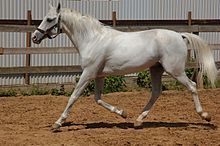 Tersk stallion Tersk stallion | |
| Conservation status | FAO (2007): endangered |
|---|---|
| Other names |
|
| Country of origin | Russian Federation |
| Distribution | Stavropol Krai |
| Use | riding horse |
| Traits | |
| Height |
|
| Colour | grey, dark colours |

The Tersk or Tersky is a Russian breed of light riding horse of Arab type. It was bred at the Tersk Stud in Stavropol Krai in the North Caucasus between about 1925 and 1940.
History
The Tersk Stud was established by Semyon Budyonny in 1921 with the aim of re-establishing the horse population of Russia, which was depleted after the events of the Russian Revolution of 1917.
Among the horses brought there in 1925 were two stallions and a few mares of the Ukrainian Strelets breed; this breed, now extinct, was a part-bred Arab with some influence of Orlov Trotter, Don and Kabardin. The two stallions, Tsenitel and Tsilindr, were used on cross-bred mares with Arab, Don, Kabardin and Strelets blood. To create the Tersk breed, the resulting mares were put to Arab stallions, among them Koheilan IV, Marosh, and Nasim. The intent was to create a riding horse of Arab type, but larger and better adapted to extensive management in the taboon system. The breed was officially recognised in 1948.
In 2007 the conservation status of the Tersk in Europe was listed by the FAO as "endangered".
Characteristics
The Tersk is similar in conformation to the Arab. It has a light head with straight profile; the shoulders are sloped, the chest broad, the back straight, the croup rounded, and the legs slender but strong. The tail is set on high. The skin is fine, as is the hair of the coat, mane and tail. The coat is often a silvery grey, but may also be bay or chestnut.
Use
The Tersk is well suited to use in eventing, in cross-country riding, in dressage and in show-jumping. It may be used for endurance riding, in which it excels; in one race over 310 km (190 mi), all participating Tersk horses finished the course without difficulty. The horses are often used in circuses.
Tersk stallions have been used for cross-breeding with other breeds such as the Lokai and the Deliboz in the hope of improving them.
References
- ^ Barbara Rischkowsky, D. Pilling (eds.) (2007). List of breeds documented in the Global Databank for Animal Genetic Resources, annex to The State of the World's Animal Genetic Resources for Food and Agriculture. Rome: Food and Agriculture Organization of the United Nations. ISBN 9789251057629. Accessed October 2014.
- ^ N.G. Dmitriev, L.K. Ernst (1989). Animal genetic resources of the USSR. FAO animal production and health paper 65. Rome: Food and Agriculture Organization of the United Nations. ISBN 9251025827. Archived 13 November 2009. Also available here, archived 29 September 2017.
- ^ Valerie Porter, Lawrence Alderson, Stephen J.G. Hall, D. Phillip Sponenberg (2016). Mason's World Encyclopedia of Livestock Breeds and Breeding (sixth edition). Wallingford: CABI. ISBN 9781780647944.
- ^ Elwyn Hartley Edwards (1994). The Encyclopedia of the Horse. London; New York; Stuttgart; Moscow: Dorling Kindersley. ISBN 0751301159.
- Tersky Horse and Streletsky Horse. Lexington, Kentucky: International Museum of the Horse. Archived 28 January 2020.
- ^ Élise Rousseau, Yann Le Bris, Teresa Lavender Fagan (2017). Horses of the World. Princeton: Princeton University Press. ISBN 9780691167206.
| Horse breeds of the Russian Federation | |
|---|---|
| These are the horse breeds considered in the Russian Federation to be wholly or partly of Russian origin. Inclusion here does not necessarily imply that a breed originates predominantly or exclusively within the Russian Federation. | |
| Contemporary |
|
| Extinct | |
| List of horse breeds | |